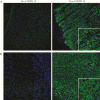Immunoserologic Detection and Diagnostic Relevance of Cross-Reactive Autoantibodies in Coronavirus Disease 2019 Patients
- PMID: 32738141
- PMCID: PMC7454719
- DOI: 10.1093/infdis/jiaa485
Immunoserologic Detection and Diagnostic Relevance of Cross-Reactive Autoantibodies in Coronavirus Disease 2019 Patients
Abstract
Background: During the coronavirus disease 2019 (COVID-19) pandemic, we detected a new immunofluorescence (IF) pattern in serum autoantibody (autoAb) screening of laboratory-confirmed COVID-19 patients.
Methods: The IF pattern was composed of liver and gastric mucosa staining on rat kidney/liver/stomach sections.
Results: We describe 12 patients positive for the cross-reactive antibody, compared with a negative group of 43 hospitalized COVID-19 patients, finding association with either neurologic or thrombotic complications. In sequential pre- and post-COVID-19 serum samples, we confirmed autoAb seroconversion.
Conclusions: Our data indicate that autoAb screening in COVID-19 patients may be easily performed by IF and alert for autoreactive-mediated complications such as thrombotic or neurologic events.
Keywords: COVID-19; autoantibody; autoimmunity; immunofluorescence; molecular mimicry.
© The Author(s) 2020. Published by Oxford University Press for the Infectious Diseases Society of America. All rights reserved. For permissions, e-mail: journals.permissions@oup.com.
Figures

Comment in
-
Autoantigens That May Explain Postinfection Autoimmune Manifestations in Patients With Coronavirus Disease 2019 Displaying Neurological Conditions.J Infect Dis. 2021 Feb 13;223(3):536-537. doi: 10.1093/infdis/jiaa703. J Infect Dis. 2021. PMID: 33159201 Free PMC article. No abstract available.
References
-
- Conrad K, Roggenbuck D, Reinhold D, Sack U. Autoantibody diagnostics in clinical practice. Autoimmun Rev 2012; 11:207–11. - PubMed
Publication types
MeSH terms
Substances
LinkOut - more resources
Full Text Sources
Medical
Miscellaneous

